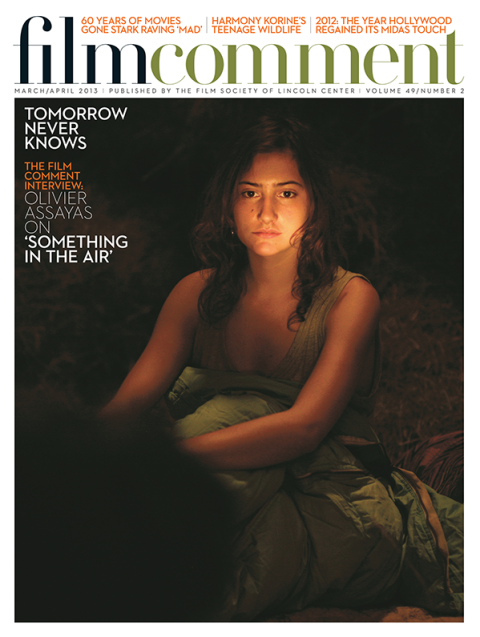
Even with 40 years to grow numb to the barrage of modish rhetoric about the collective American psyche unleashed in End of the Road, this unruly 1970 portrait of post-counterculture casualties and chaos remains an unsettling and uneven viewing experience. Given its impressive yet aesthetically divergent team of collaborators—screenwriter Terry Southern, director Aram Avakian, cinematographer Gordon Willis, jazz producer George Avakian supervising the score—the natural impulse is to declare the disjointed end product a case of too many cooks.
Yet the straddling of multiple political positions, tonal shifts, and aesthetics in this eccentric snapshot of a fractured era is intentional. The film’s tale of a young professor’s disastrous affair with a colleague’s wife reveals all worldviews to be equally undesirable, as if mirroring the notion of “cosmopsis”—paralysis induced by an awareness of all possible options—described in the original book by John Barth.
Barth’s 1958 novel, set in the early Fifties, is about what happens when existentialism is pushed to its logical end. The film, set in the late Sixties, is about the exhaustion of a decade. At some moments brilliantly expanding upon its source material, at others broaching seemingly antithetical territory, End of the Road introduces the pervasive fatigue of its characters through familiar but effective tactics: an opening montage of U.S. soldiers, Vietnamese civilians, race riots, demonstrations, and an inverted American flag is intercut with scenes of brawling graduates in caps and gowns. These conflicting series of images—one reflecting the liberal viewpoint of the era, the other a conservative burlesque of student protest—are expertly constructed despite being considered clichés well before the film’s release.*

Out of this summary vision of the state of national discourse emerges the expressionless Jacob Horner (Stacy Keach), who walks past the melee of his graduating class and wanders into a train station, only to stand stiffly on the platform at soldierlike attention as passengers and trains go by. His detachment and lack of affect amount to neither a political statement nor a philosophical malady, but rather symptoms of a state of catatonia induced by a cruelly schizophrenic world. As Billie Holiday woefully wails “Don’t worry ’bout me” on the soundtrack, a “Kodak baby montage” (as Avakian called it) pairs photos of Jacob as a toddler, in high school, etc. with footage and snapshots that constitute a greatest hits of mid-century world history (Hitler and his generals, nuclear bomb tests, Detroit riots, Martin Luther King Jr.’s funeral). The contrast between these two sets of documentary images portrays the simultaneously privileged and feckless nature of postwar white heterosexual youth, the whole existential experience condensed into five minutes.
Doctor D (James Earl Jones), a caustic figure invented by Southern, “rescues” Jacob from the station. Reminiscent of Malcolm X with his horn-rimmed glasses, smart suit, manicured beard, and dynamic oratory, the Doctor ritualistically struts around his newfound patient while chanting cat-ta-to-ni-ya, then hauls him off to The Institute of Psychic Remobilization. The Institute, aka The Farm, is located in a large New England house of seemingly variable dimensions and holds an unlimited supply of lunatics, fellow casualties of the Sixties: dancing longhairs, a naked woman shouting free love poetry while being mounted by an attendant, a sniper with a wooden rifle.
Far from being throwaway gags, The Farm’s happenings serve to ridicule hippie-dom. As Doctor D notes, each of these patients, locked in a personal fantasy, plays the hero in the story of his/her life and relegates others to supporting-character status—they are self-absorbed to the point of total isolation. Jacob meanwhile is led to a darkened room containing two facing chairs bolted to the floor a foot apart. Like epic figures in some demented opera, doctor and patient spar verbally and physically. Slide-shows on the walls present a wraparound montage of pornography, geometric patterns, and American flags, punctuated by the din of recorded gunfire, wailing babies, and Doctor D bellowing questions. Between treatments, Jacob glimpses other patients engaged in deviant behavior, from sadomasochistic cross-dressing to bestiality (which helped earn the movie its X rating).

The second half of the film takes on Nixon’s “silent majority.” Upon his release from The Farm, Jacob gets a teaching position at a small college and befriends Joe Morgan (Harris Yulin) and his wife Rennie (Dorothy Tristan), a young couple whose incessant need to “think out” their philosophical convictions has degraded into nihilism. After a brief affair with Jacob, Rennie becomes pregnant, but is unsure of who the father is. She insists on getting an abortion immediately, over Jacob’s protests. Unable to secure an abortionist, Jacob calls upon Doctor D.
The ensuing abortion scene is truly harrowing, and far more potent and tough than the fashionable counterculture satire that precedes it. An anxious Rennie is stretched out in the same room at The Farm in which Jacob received his treatments. Doctor D inserts a curette, causing her to convulse in blind, thrashing terror, and as he rushes to sedate her, she vomits inside her anesthesia mask and chokes to death. This grisly denouement is more than just a final controversial gesture. Acknowledging the reality of the physical stress of an abortion flies in the face of pro-choice advocacy, while its presentation as not just an option but the only option is just as deeply problematic for the pro-life contingent. The audacity of actually depicting the procedure—before it was legal in most states—makes End of the Road a bitterly important record of a divided nation, and one that successfully pierces through the empty pageantry on both sides of the divide.
*Pauline Kael dismissed the film’s montages as “opportunistic assertions.” This was the stated reason for her solid pan, though it’s clear from her review and first-person accounts that she was incensed by an eight-page Life magazine feature praising it, which she (along with Judith Crist) felt was more a matter of taste-making than film criticism.








